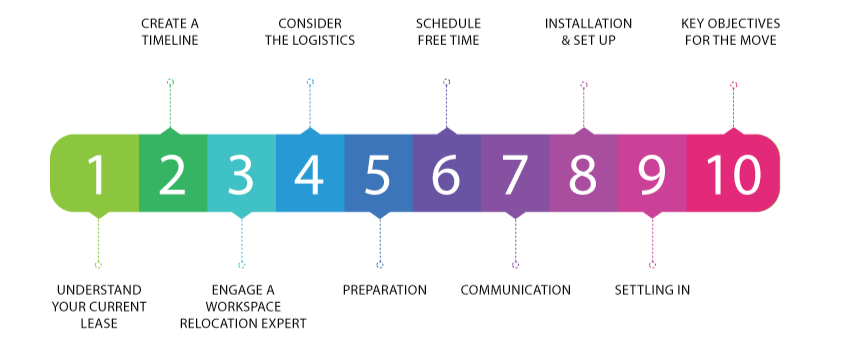
Here are a few top tips to make the process as pain-free as possible:
Understand your current lease Ensure that you have examined your current lease agreement to understand your commitments to the current landlord. Although some agreements allow you to leave your current fitout in place, some leases specify that you must return the tenancy to a warm shell by stripping out any built environments. This will of course affect your budget and timeline. If no ‘make-good’ work is necessary, organise an end-of-lease clean of the space to be carried out after vacating.
Create a timeline Begin by creating a timeline counting back from the physical move date to plan effectively for your relocation. It is a complex process with many considerations and actions and should be completed up to six months prior to the move. Designating a relocation team within the business will distribute the responsibilities to ease the management of the process. Remaining ahead of the game with advance planning will negate any potential risks to business operations and disruption and ensure that you have time to negotiate any overlap of the existing and new lease timing.
Engage a workspace relocation expert Investigate several workplace moving specialists before making your decision. These companies relocate offices every single day, so take their planning advice on board. They will be able to provide you with a checklist with associated planning time.
Consider the logistics If you have planned the fitout and relocation journey well, your team will be able to transition directly from the current to the new space. However, if this isn’t possible, consider whether your team can work remotely or whether you must budget for a temporary workspace in the interim. A flow-on from this is whether you require storage solutions between the 2 premises.
Preparation Firstly, it is advisable to assign a relocation leader from each department who will drive the packing and labelling of equipment. When it comes to the physical move, discuss what assistance you will need from your relocation provider to dismantle work settings, then create an inventory of all existing furniture and equipment that will be moving to the new office. Provide the relocation team with a floorplan layout of the new space to define which area equipment should be dropped off on arrival.
Communication The communication piece is relevant both internally to staff and externally to clients and service providers. Notice of an address change is essential for clients who may visit the office as well as internet and phone providers, financial institutions, insurance companies and any additional services that provide regular deliveries.
Communication also covers updates to internal documents, external templates such as invoices, website alterations and a change to your address on Google.
Installation and set-up To avoid any business disruption, organise assistance to set up any internet and telephony immediately. Arrange with your new building manager that there is provision for parking and unpacking as well as that services and utilities are switched on such as aircon and power.
Settling-in Have an IT expert on hand to ensure that all computers, telephony and technology are set up and working to avoid any business disruption.
Key objectives for the move Although you may have involved the wider team in the key objectives and drivers for the new workspace at the beginning of the fitout journey, take time to gather your employees after the move to further discuss the new environment.
To maximise work effort, productivity and employee satisfaction, identify the variety of work zones, their purpose, and how they will support any tasks and work methods of the different teams. This process will serve to attract remote workers back to the office and get any doubters on board.
And last, but not least, keep the lines of communication open. Create an environment where feedback is encouraged.
Talk to us now about your lease expiry, we’re always happy to guide our clients on the best solution.

-Emailfooter.png?width=100&height=82&name=TRUE%20(White%20Trans)-Emailfooter.png)
